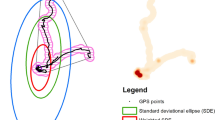Abstract
This study identifies the daily activity pattern of a city slum in Calcutta and analyzes the socio-economic correlates and proposes activity pattern models. The study area, Tangra slum is located in a low-lying poorly drained area where cheap land has led to the development of a large number of factories, and a cattle slaughter house; places of employment for unskilled labor. The ideal location of the slum in relation to entertainment, medical clinics, transportation nodes, shopping facilities has generated a diverse activity pattern. Activities were observed to be of two natures, essential and non-essential. The two types of activities differed in their frequency with the essential activities having high frequency and the non-essential having low frequencies. Typically it was also observed that high frequency activities were limited to a radii of 5 km (3 miles) from the slum whereas, the low frequency activities radiated for 100–160 km (60 to 100 miles) from the slum.
Similar content being viewed by others
Reference
Dutt, Ashok K.: Daily Shopping in Calcutta. The Town Planning Review 37, 3, 207–216 (October, 1966)
Author information
Authors and Affiliations
Rights and permissions
About this article
Cite this article
Mukhopadhyay, A., Dutt, A.K. Slum dweller's daily movement pattern in a Calcutta slum. GeoJournal 29, 181–186 (1993). https://doi.org/10.1007/BF00812815
Issue Date:
DOI: https://doi.org/10.1007/BF00812815




